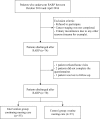Extended nursing for the recovery of urinary functions and quality of life after robot-assisted laparoscopic radical prostatectomy: a randomized controlled trial
- PMID: 29196816
- PMCID: PMC5876261
- DOI: 10.1007/s00520-017-3988-x
Extended nursing for the recovery of urinary functions and quality of life after robot-assisted laparoscopic radical prostatectomy: a randomized controlled trial
Abstract
Purpose: The purpose of this work is to explore the effects of continuing nursing care intervention on postoperative urinary control and quality of life among patients with prostate cancer.
Methods: This was a single-center, parallel, and randomized controlled trial that was carried out at the Department of Urology, the First Affiliated Hospital of Anhui Medical University, China. The participants underwent robot-assisted laparoscopic radical prostatectomy (RARP) between October 2014 and April 2016. The patients were randomized to the experimental and control groups (n=37/group). Patients in the control group received routine nursing care, while patients in the experimental group received continuing nursing care. During the 6-month follow-up, each patient was invited at the hospital discharge and at 1, 3, and 6 months to fill the ICI-Q-SF and SF-36 questionnaires.
Results: The scores of urinary incontinence were improved in the intervention group compared with controls at 3 and 6 months after discharge (both P < 0.01). The scores of quality of life in the experimental group were significantly higher than control group at 1, 3, and 6 months (all P < 0.01). Adverse events were mild or moderate in intensity and were resolved in all patients. All adverse events were related to RARP.
Conclusions: Continuing nursing care intervention had significant beneficial effects on urinary functions and quality of life in patients with prostate cancer after RARP. This approach warrants to be promoted in the clinical setting.
Keywords: Nursing; Prostate cancer; Quality of life; Urinary function.
Conflict of interest statement
Conflict of interest
The authors declare that there is no conflict of interest.
Research involving human participants
This study was approved by the ethics committee of Anhui Medical University (ID 20170398).
Informed consent
All patients provided a signed informed consent.
References
-
- Fraser M, Sabelnykova VY, Yamaguchi TN, Heisler LE, Livingstone J, Huang V, Shiah YJ, Yousif F, Lin X, Masella AP, Fox NS, Xie M, Prokopec SD, Berlin A, Lalonde E, Ahmed M, Trudel D, Luo X, Beck TA, Meng A, Zhang J, D’Costa A, Denroche RE, Kong H, Espiritu SM, Chua ML, Wong A, Chong T, Sam M, Johns J, Timms L, Buchner NB, Orain M, Picard V, Hovington H, Murison A, Kron K, Harding NJ, P’ng C, Houlahan KE, Chu KC, Lo B, Nguyen F, Li CH, Sun RX, de Borja R, Cooper CI, Hopkins JF, Govind SK, Fung C, Waggott D, Green J, Haider S, Chan-Seng-Yue MA, Jung E, Wang Z, Bergeron A, Pra AD, Lacombe L, Collins CC, Sahinalp C, Lupien M, Fleshner NE, He HH, Fradet Y, Tetu B, van der Kwast T, McPherson JD, Bristow RG, Boutros PC. Genomic hallmarks of localized, non-indolent prostate cancer. Nature. 2017;541(7637):359–364. doi: 10.1038/nature20788. - DOI - PubMed
Publication types
MeSH terms
LinkOut - more resources
Full Text Sources
Other Literature Sources
Medical
Miscellaneous


